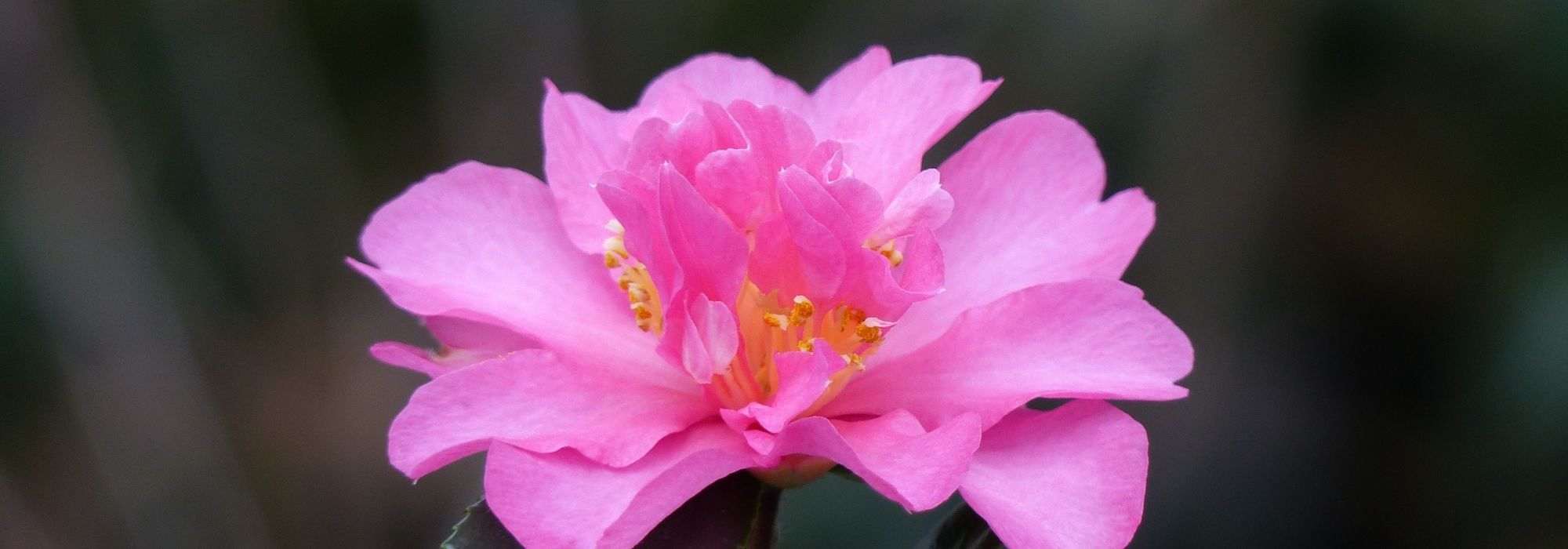
How to pair autumn camellias?
Ideas and inspirations for pot or open ground cultivation
Contents
Autumn camellias (Camellia sasanqua) are shrubs that flower in autumn, sometimes extending into early winter. Their evergreen foliage, fragrance, and soft pink, white, or red colours are all assets for enhancing the garden late in the season.
Preferring shade or partial shade, they thrive in fresh, light, acidic heather soil rich in humus, and can be grown both in pots and in the ground. These shrubs can easily be paired with other plants that share similar needs and have overlapping flowering or fruiting periods.
Let’s explore which combinations are possible to create a beautiful floral atmosphere in the garden with sasanqua camellias.
In pots on a terrace or balcony to brighten up autumn
The smallest varieties of autumn-flowering camellias, measuring barely 1 metre in height, can easily be grown in pots. This is the case for Camellia sasanqua ‘Versicolor’, ‘Frosted Star’, or ‘Variegata’ (1 metre in height with a spread of 80 cm). The small autumn camellia ‘Interlude’ also forms a lovely compact bush of 80 cm in all directions.
Accompany these pink and white flowers with other shrubs in similar tones, which can also be grown in pots. The small dimensions (1.2 metres in height with a spread of 1 metre) of the clerodendron Clerodendrum bungei ‘Pink Diamond’ are suitable for pot cultivation. Its dark pink flowering at the end of summer, complemented by lovely variegated foliage, will precede the flowering of our autumn camellias.
This will also be the case with crape myrtles such as Lagerstroemia indica ‘Houston’ or ‘Mardi Gras’, which will precede the camellia flowering with their large frilly pink panicles. ‘Pixie White’, with its white flowering at the end of summer, will also work well to accompany the camellias in a pot on the terrace or balcony.
A vitex or chaste tree can also make a good companion. Opt for smaller varieties like ‘Pink Pinnacle’. And if you love blue flowers, try the long panicles of the adorable ‘Blue Puffball’. After flowering, small aromatic fruits resembling dark red shiny peppercorns form, persisting through winter to accompany the flowering of sasanqua camellias.
If you choose to grow in a large container, you can accompany your autumn camellia with low plants that prefer acidic soils in the same pot. This includes white or pink heathers and creeping gaultherias, with their lovely decorative fruits shaped like small red bells during winter. Also consider the sweet violet, with its evergreen foliage and fragrant flowering, which will follow that of the camellias in spring.
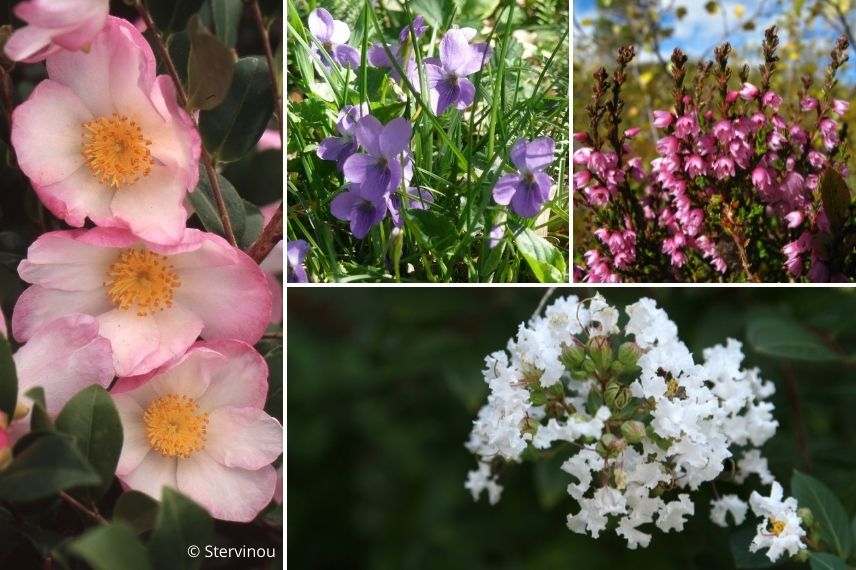
Camellia ‘Versicolor’, Viola odorata (photo nociveglia), Calluna ‘Marlies’ (photo Ole Husby) and Lagerstroemia indica ‘Pixie White’ (photo Jim the Photographer)
Read also
6 autumn camellias to discoverIn a flowering hedge with other acidic soil shrubs
Autumn camellias pair perfectly with other heather soil bushes, creating a lovely flowering hedge.
Turn to the essentials hydrangeas, which will precede the flowering of our autumn camellias. Choose varieties that thrive in partial shade. For example, try Hydrangea involucrata ‘Yoraku Tama’, a Japanese variety with multiple qualities: compact habit, flowering with large, pearly pink umbels that can last until November to accompany our camellias.
The witch hazels are also essential candidates, with their charming winter flowering.
For a long-flowering border, rhododendrons and azaleas will also be ideal companions: choose early varieties that will bloom in late winter or very early spring to take over. This is the case for the small Rhododendron impeditum with its bright purple colour. Japanese azaleas like ‘Koromo Shikibu’, ‘Kirin’, or ‘Hino-Crimson’ will also be perfect.
And for abundant autumn flowering, discover the amazing hybrid azaleas from the ‘Encore’ collection, which have the unique feature of blooming at least twice: from March to June, then in September-October, and even a third time from July to August in case of a hot, sunny summer. ‘Autumn Fire’ or ‘Autumn Creach’ will thus accompany our red camellia Camellia x hiemalis ‘Bonanza’ with its early flowering. The immaculate white of ‘Lily’ will pair beautifully with all shades, while the pink varieties ‘Carnival’ or ‘Empress’ will create beautiful harmonies with our camellias.
Don’t forget the Clethra alnifolia, with its late white, fragrant flowering and beautiful foliage that turns golden yellow in autumn.
And to add an extra decorative touch in winter, opt for skimmias. While they bloom in spring, their red or white fruit persists into winter, and they retain their attractive foliage all year round.
If you have enough space, a strawberry tree with beautiful autumn bell-shaped white flowers, paired with decorative, delicious fruits, will be a wonderful addition.
And for an original exotic touch in mild regions (hardiness around -10°C), try the magnificent Eucryphia x Intermedia ‘Rostrevor’, flowering from August to September. It will look stunning in the background with its large silhouette (6.5 metres tall and 2 metres wide).
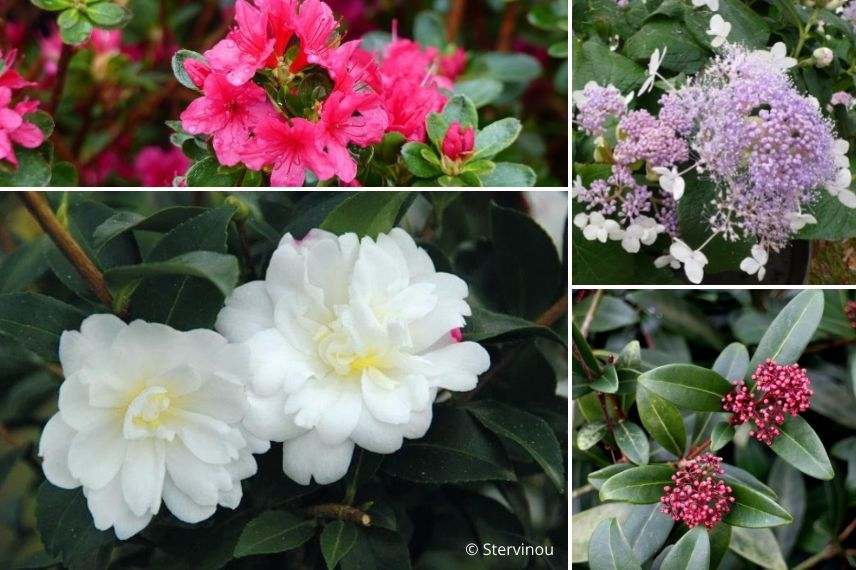
Japanese azalea ‘Hino Crimson’, Hydrangea involucrata ‘Late Love’, Camellia ‘Fuji no Yuki’ and Skimmia japonica ‘Rubella’ (photo Wikipedia)
Discover other Autumn Camellia
View all →Available in 1 sizes
Available in 1 sizes
Available in 1 sizes
Available in 1 sizes
Available in 1 sizes
Available in 1 sizes
Available in 1 sizes
Available in 1 sizes
Available in 1 sizes
Available in 1 sizes
To dress the feet of autumn camellias
The largest autumn camellias can reach up to 3 metres in height. To dress their bases, consider the many small-flowered plants, groundcovers, or those with a spreading habit that bloom in autumn.
For bulbous plants that enjoy the same type of exposure, look towards colchicums, whose colours will harmoniously complement the flowers of the camellias. Pink Naples cyclamen or white ones, delicate nerines, wild asters, or even liriopes will also work very well.
In terms of foliage, enjoy the decorative fronds of ferns, such as asplenium, which have the advantage of being evergreen.
To take over at the end of winter, consider early crocuses like Crocus imperati ‘De Jager’ (flowering in January-February), the sunny winter aconite that can show the tips of its petals as early as the end of January, or the delicate snowdrops.
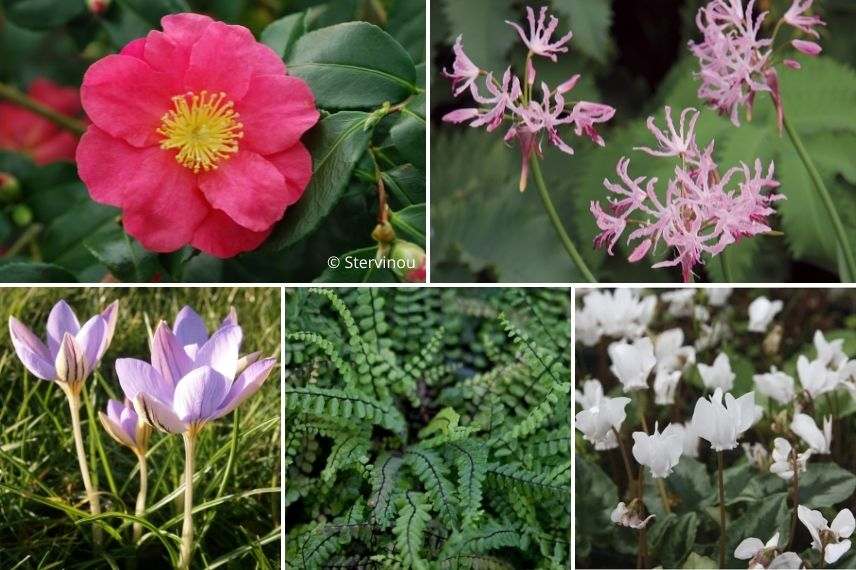
Camellia sasanqua ‘Sekiyo’, Nerine undulata (photo michael wolf), Crocus imperati ‘De Jager’, Asplenium trichomanes and Cyclamen hederifolium
Read also
Camellias: planting, pruning and careIn a border with long flowering during the cold season
By combining different varieties of autumn camellias, you ensure an almost continuous flowering from early autumn to the end of winter.
Choose early varieties ‘Showa no Sakae’, ‘Choji Guruma’, and ‘Sekiyo’, which bloom as early as September. ‘Early Pearly’ also flowers early in the season, starting in October.
Pair them with later or long-flowering camellias, such as Camellia x hiemalis ‘Bonanza’, which blooms from October to January, or ‘Yume’, which flowers abundantly from October through December-January.
Also cultivate the Camellia grijsii, which will take over from January to March, providing a beautiful colourful display during the coldest months of the year.

Autumn camellia ‘Showa no sakae’, Camellia ‘Bonanza’, Camellia grijsii, and Camellia sasanqua ‘Yume’
In a Japanese-inspired garden
Are you looking for a calming atmosphere that lends itself to rest and meditation? A Japanese-inspired garden is ideal.
In a heather soil bed, autumn camellias will perfectly suit this type of ambiance. Opt for ‘Narumi Gaita’, whose flowers resemble Japanese anemones, or the twisted silhouette and supple branches of ‘Gay Border’.
With them, consider other camellias, such as Camellia japonica ‘de Higo Fuji’, which blooms between January and March.
Japanese azaleas from the ‘Encore’ collection will again be ideal companions, with their red or pink flowers creating lovely harmonious gradients.
To complete the picture and take over flowering in spring, turn to Japanese andromedas, such as Pieris japonica ‘Katsura’, or ‘Little Heath’ with its particularly decorative evergreen foliage. Both are in bloom from February to April.
For foliage, choose plants with beautiful autumn colours to accompany our camellias. Consider the diverse ferns, for example Osmunda japonica, with its modest silhouette, which retains its green foliage until late in the season before turning a lovely reddish hue and disappearing.
Some skimmias will also be perfect, with their evergreen foliage and decorative red berries in winter.
Japanese dogwoods will offer vibrant colours in autumn, such as Cornus kousa ‘Satomi’ and ‘Scarlet Fire’.
Essential if you have enough space, to bring height and lightness to a Japanese-inspired garden, the majestic Japanese maples and prunus will be reliable choices. They will be grown in isolation.
You can also choose the bluish evergreen foliage of an eucalyptus, which will create a lovely colour harmony with pink or white Camellia sasanqua.
For a more original touch, also try the Japanese loquat, with its exotic appearance, a fruit tree with decorative evergreen foliage all year round and autumn flowering.
And to dress a small space or terrace in a Japanese garden, complete the picture with a few pots of sacred bamboo with vibrant colours.
Stones, gravel, statues, small bridges, fountains… all decorative elements that will contribute to a Japanese atmosphere.
For more information, feel free to check our article on how to create a Japanese or Zen garden.
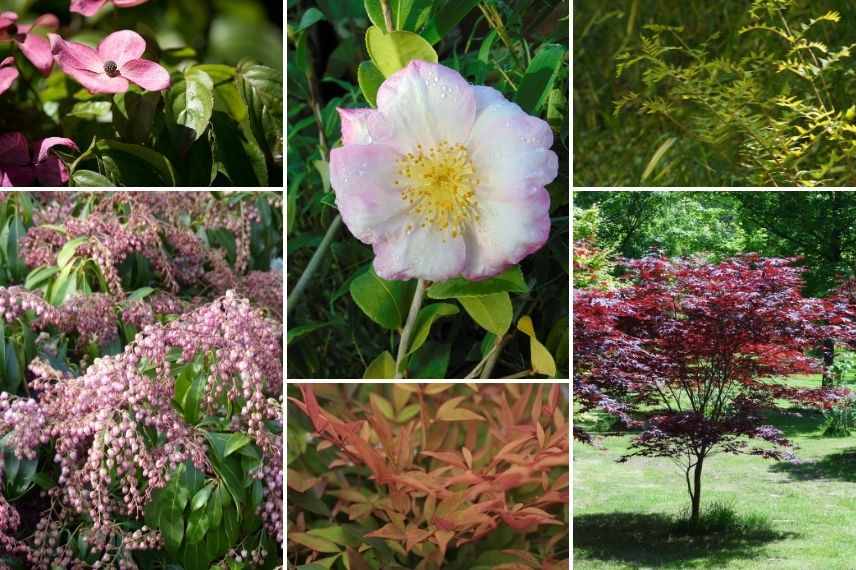
Cornus kousa ‘Satomi’, Camellia ‘Gay Border’, Osmunda japonica (photo Harum.koh2), Japanese andromeda ‘Katsura’, Nandina domestica ‘Obsessed Seika’ and Acer palmatum ‘Atropurpureum’
For a garden of a thousand scents
If you wish to create a garden of scents as beautiful as it is fragrant, autumn camellias will offer you a choice of floral, fruity, or even spicy fragrances. Opt for the spicy scent of ‘Gay Border’, the enchanting jasmine tea fragrance enhanced by delicious notes of plum from ‘Versicolor’, or the more floral and heady scent of ‘Setsugekka’ and ‘Frosted Star’.
To take over, daphnes will perfume the spring, such as Daphne odora ‘Aureomarginata’, ‘Perfume Princess’, or ‘Maejima’.
Larger, witch hazels can also offer their beautiful fragrant flowering at the end of winter.
In spring, wild camellias like ‘Scentsation‘ will announce the return of warmth with their intense fragrance.
In summer, it will then be clethra (‘Vanilla Spice’) and gardenias (‘Summer Snow’, ‘Crown Jewel’), which will perfume the garden.

Autumn camellia ‘Frosted Star’, Camellia ‘Cinnamon Scentsation’, Daphne ‘Perfume Princess’, Clethra alnifolia ‘Vanilla Spice’ (photo Denolf) and Gardenia ‘Crown Jewel’
For further reading
- Discover also 7 classic white camellias
- Subscribe!
- Contents
































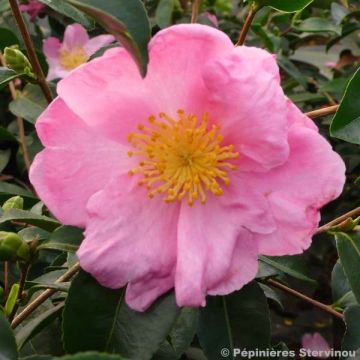

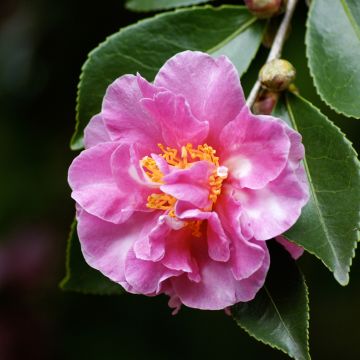
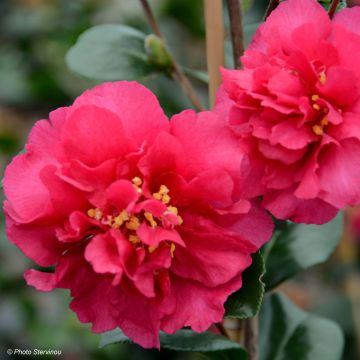
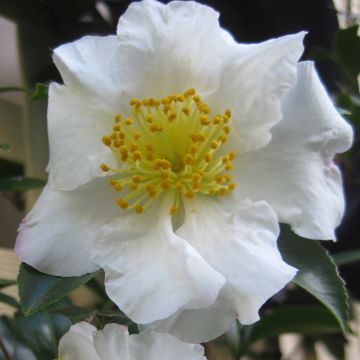


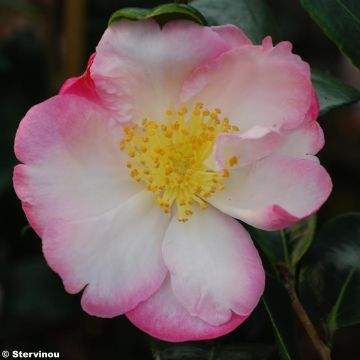


Comments